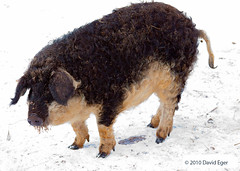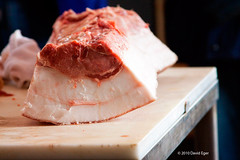The best food starts with the best ingredients.
That’s true in your restaurant, isn’t it? You look high & low for the best stuff available … because that’s why your customers come in for a meal.
And, if you can’t find it from a purveyor, you make it yourself, right?
Just like the well-established trends to higher quality in American beer, wine, cheese, breads, and other craft foods, there is small, but growing movement toward better meat-based products across the country. And for true connoisseurs of salumi & charcuterie, the Mangalitsa hog is considered among the best sources anywhere.
Though less well known than it’s Spanish cousin, the Iberian Black hog, Mangalitsas have a similar ability to put on fat … and anyone who’s made tasty treats with pork knows, that lots of fat is essential to the best flavor, texture, & mouth-feel!
Pigstock Traverse City is your opportunity to work with this hog in an extremely intimate three-day event. You will observe, then experience hands-on, the raising, slaughter, and processing of Mangalitsas from start to finish.
You will learn Old World methods of seam butchery, which allow for more complete utilization of the whole animal, and are especially designed for high-quality whole-muscle preparations.
Your primary presenters are two Austrian-trained expert butchers & farmers: Christof and Isabel Wiesner. This is one of only three events this year in North America to gain this knowledge straight from the source. It is exceedingly rare to have access to these techniques outside of Europe, and space is limited.
So … please contact us today to reserve your spot!
Cherry Capital Foods - (231) 943-5010
Dave Hovest - dave@cherrycapitalfoods.net
Lee Michaels - lee@cherrycapitalfoods.net
Earthy Delights - (800) 367-4709
Ann Marie Pooler - annmarie@earthy.com
Leslie Arnell - leslie@earthy.com
Chambre Beauvais - chambre@earthy.com
Mike Helmer - mike@earthy.com
Chef David Eger - chefdavid@earthy.com
This three-day course is designed to provide you with an appreciation of what makes the Mangalitsa unique, from its breeding & raising practices, to the methods of processing a hog from the inside all the way out, and finally to produce world class salumi & charcuterie products. We’ve also lined-up two well-known American experts in salumi & charcuterie, to round out the knowledge you can acquire by signing-up for this event.
Here are ALL the details:
Day 1: On the farm in Marion, Michigan
Michigan Mangalitsa will host you at their farm where the pigs are raised & fattened. We will process 6 hogs that day, from kill to ready-to-chill carcasses.
Christof will demonstrate and then oversee the kill and carcass preparations, while Isabel will work with the various internal organs. There will also be an amazing catered lunch & evening pig roast from the celebrated Traverse City’s restaurant The Cook’s House, something you definitely don’t want to miss!
Days 2 and 3: On the campus of the Great Lakes Culinary Institute in Traverse City, Michigan
Classes on these days will teach you the fine art of seam butchery as taught by Christof.
And you will have an opportunity to try everything with your own hand.
Isabel will cook and process the internal organs, with help from class participants.
Everything from kidneys and lungs to headcheese and blood sausage will show up on platters to be tried by all. Come see how to prepare everything but the squeal; absolutely nothing goes to waste!
There will also be detailed presentations with Michigan’s own charcuterie expert, Brian Polcyn, co-author of the James Beard Award nominated book, Charcuterie, and Rey Knight of Knight Salumi Company in San Diego, who will join the Wiesners to demonstrate the entire process of producing dry-cured hams and fermented, dried sausages, utilizing the Mangalitsa cuts made earlier.
Meet the Presenters:
Christof Wiesner was born and raised in Vienna, Austria. He has been breeding and raising Mangalitsa hogs since 1999. Christoph was trained by Austria's best butcher, Marcel Kropf, in animal slaughter and seam butchery. In 2004 he became president of Austria’s Mangalitsa Pig Breeder’s Union. At their farm in Göllersdorf, Arche De Wiskental, Christoph and Isabell breed rare, native Austrian farm animals, as well as local agricultural crops.
Isabell-Christina Zernitz-Wiesner attended the College for Occupation in Service Industries Management and studied at the University of Agriculture. She has been farming full time with Christof since 2006, and organizes regular events at the farm, and well as the direct marketing of the farm’s produce.
Brian Polcyn is an award winning chef and nationally recognized charcuterie expert. In addition to running two of Michigan’s best restaurants, he is also a chef instructor at Schoolcraft College in Livonia. He and Micheal Ruhlman were co-authors of the 2005 book, Charcuterie, considered by many to be one of the most accessible books available on the topic.
Both Brian and this book have been nominated for James Beard awards.
Rey Knight is the founder of Knight Salumi Company. A life-long chef, he was formally trained at the Culinary Institute of America. He specializes in producing salumi and other dry-cured meats without nitrates or nitrites, using time-honored, but largely forgotten Old World techniques.





